Uncharged Monolithic Carbon Fibers Are More Sensitive to Cross-Junction Compression than Charged
Abstract
:1. Introduction
2. Experimental
2.1. Fabrication of MACCE System
Electrode Fabrication
2.2. Electromechanical Characterization of MACCE
2.2.1. Pressure Sensitivity
2.2.2. Measurements in Electrolytic Media
2.2.3. MACCE Charging
3. Results and Discussion
3.1. Pressure-Dependent Conductance in MACCE
3.2. Conductance Enhancement in MACCE through Electrolyte Interaction
3.3. Effect of Charge on MACCE Pressure-Sensitivity
3.4. Pressure Sensitivity and Conductance Dynamics in MACCE
4. Conclusions
Author Contributions
Funding
Institutional Review Board Statement
Informed Consent Statement
Data Availability Statement
Conflicts of Interest
References
- Pons, J.L. Wearable Robots: Biomechatronic Exoskeletons; John Wiley & Sons: Hoboken, NJ, USA, 2008. [Google Scholar]
- Popović, M.B. Biomechanics and Robotics; CRC Press: Boca Raton, FL, USA, 2013. [Google Scholar]
- Naeem, M.A.; Javed, K.; Fraz, A.; Anwar, F. Recent trends in wearable Electronic textiles (e-Textiles): A mini review. J. Des. Text. 2023, 2, 62–72. [Google Scholar] [CrossRef]
- Choudhry, N.A.; Arnold, L.; Rasheed, A.; Khan, I.A.; Wang, L. Textronics—A Review of Textile-Based Wearable Electronics. Adv. Eng. Mater. 2021, 23, 2100469. [Google Scholar] [CrossRef]
- Wang, C.; Zhang, M.; Xia, K.; Gong, X.; Wang, H.; Yin, Z.; Guan, B.; Zhang, Y. Intrinsically stretchable and conductive textile by a scalable process for elastic wearable electronics. ACS Appl. Mater. Interfaces 2017, 9, 13331–13338. [Google Scholar] [CrossRef] [PubMed]
- Ha, M.; Lim, S.; Ko, H. Wearable and flexible sensors for user-interactive health-monitoring devices. J. Mater. Chem. B 2018, 6, 4043–4064. [Google Scholar] [CrossRef]
- Gao, W.; Ota, H.; Kiriya, D.; Takei, K.; Javey, A. Flexible Electronics toward Wearable Sensing. Acc. Chem. Res. 2019, 52, 523–533. [Google Scholar] [CrossRef] [PubMed]
- Jost, K.; Dion, G.; Gogotsi, Y. Textile energy storage in perspective. J. Mater. Chem. A 2014, 2, 10776. [Google Scholar] [CrossRef]
- Wang, J.; He, J.; Ma, L.; Zhang, Y.; Shen, L.; Xiong, S.; Li, K.; Qu, M. Multifunctional conductive cellulose fabric with flexibility, superamphiphobicity and flame-retardancy for all-weather wearable smart electronic textiles and high-temperature warning device. Chem. Eng. J. 2020, 390, 124508. [Google Scholar] [CrossRef]
- Shi, Y.; Dong, W.; Lin, W.; Gao, Y. Soft wearable robots: Development status and technical challenges. Sensors 2022, 22, 7584. [Google Scholar] [CrossRef] [PubMed]
- Wu, Y.; Yang, Y.; Li, C.; Li, Y.; Chen, W. Flexible and electroactive textile actuator enabled by PEDOT:PSS/MOF-Derivative Electrode Ink. Front. Bioeng. Biotechnol. 2020, 8, 212. [Google Scholar] [CrossRef]
- Vasiljević, T.; Baćić, M.; Laušević, M.; Onjia, A. Surface composition and adsorption properties of activated carbon cloth. Mater. Sci. Forum 2004, 453–454, 163–168. [Google Scholar] [CrossRef]
- Dai, P.; Zhang, S.; Liu, H.; Yan, L.; Gu, X.; Li, L.; Liu, D.; Zhao, X. Cotton fabrics-derived flexible nitrogen-doped activated carbon cloth for high-performance supercapacitors in organic electrolyte. Electrochim. Acta 2020, 354, 136717. [Google Scholar] [CrossRef]
- Sun, Q.; Yu, D.; Mo, F.; Wu, M.; Liu, Y.; Dong, X. Wool textile-derived nitrogen-doped porous carbon cloth for a binder-free electrode material for high-performance flexible solid-state supercapacitors. J. Mater. Sci. 2020, 56, 2412–2424. [Google Scholar] [CrossRef]
- Uduste, I.; Kaasik, F.; Johanson, U.; Aabloo, A.; Must, I. An All-Textile non-muscular biomimetic actuator based on electrohydrodynamic swelling. Front. Bioeng. Biotechnol. 2020, 8, 408. [Google Scholar] [CrossRef] [PubMed]
- Syzoniuk, O.; Banerji, S.; Aabloo, A.; Must, I. A decrease in impedance of monolithic activated carbon cloth electrodes at increased charge density. In Proceedings of the 2023 IEEE International Conference on Soft Robotics (RoboSoft), Singapore, 3–7 April 2023. [Google Scholar] [CrossRef]
- Lv, X.; Huang, W.; Shi, Q.; Tang, L.; Zhou, D. Hydrothermal activated carbon cloth as electrode materials for symmetric supercapacitors. Ionics 2019, 26, 1457–1464. [Google Scholar] [CrossRef]
- Maddah, H.A.; Shihon, M.A. Activated Carbon Cloth for Desalination of Brackish Water Using Capacitive Deionization; InTech eBooks; IntechOpen: London, UK, 2018. [Google Scholar] [CrossRef]
- Yu, Q.; Ge, R.; Wen, J.; Du, T.; Zhai, J.; Liu, S.; Wang, L.; Qin, Y. Highly sensitive strain sensors based on piezotronic tunneling junction. Nat. Commun. 2022, 13, 778. [Google Scholar] [CrossRef] [PubMed]
- Stassi, S.; Canavese, G.; Cosiansi, F.; Gazia, R.; Fallauto, C.; Corbellini, S.; Pirola, M.; Cocuzza, M. Smart piezoresistive tunnelling composite for flexible robotic sensing skin. Smart Mater. Struct. 2013, 22, 125039. [Google Scholar] [CrossRef]
- Nouri, H.; Rajendran, D.; Ramalingame, R.; Kanoun, O. Homogeneity Characterization of Textile-Integrated Wearable Sensors based on Impedance Spectroscopy. Sensors 2022, 22, 6530. [Google Scholar] [CrossRef] [PubMed]
- Ghouri, A.S.; Aslam, R.; Siddiqui, M.S.; Sami, S.K. Recent progress in Textile-Based flexible supercapacitor. Front. Mater. 2020, 7, 58. [Google Scholar] [CrossRef]
- Liu, X.; Xu, W.; Zheng, D.; Li, Z.; Zeng, Y.; Lu, X. Carbon cloth as an advanced electrode material for supercapacitors: Progress and challenges. J. Mater. Chem. A 2020, 8, 17938–17950. [Google Scholar] [CrossRef]
- Tian, K.; Chen, C.; Li, Q.; Cao, X.; Chen, X.; Fu, Q.; Deng, H. Evaporation-Induced Closely-Packing of Core–Shell PDMS@Ag Microspheres Enabled Stretchable Conductor with Ultra-High Conductance. Adv. Funct. Mater. 2023, 33, 2308799. [Google Scholar] [CrossRef]
- Euler, L.; Guo, L.; Persson, N.-K. Influence of the Electrolyte concentration and amount on the Performance of Textile Electrodes in Electrostimulation: A systematic study. Sens. Actuators A Phys. 2024, 366, 115010. [Google Scholar] [CrossRef]
- Azeem, M.; Shahid, M.; Masin, I.; Petru, M. Design and development of textile-based wearable sensors for real-time biomedical monitoring; a review. J. Text. Inst. 2024, 1–16. [Google Scholar] [CrossRef]
- Li, S.; Li, H.; Lu, Y.; Zhou, M.; Jiang, S.; Du, X.; Guo, C. Advanced Textile-Based wearable biosensors for healthcare monitoring. Biosensors 2023, 13, 909. [Google Scholar] [CrossRef] [PubMed]
- De Souza, J.; Brinkmann, M.; Mohrdieck, C.; Arzt, E. Enhancement of capillary forces by multiple liquid bridges. Langmuir 2008, 24, 8813–8820. [Google Scholar] [CrossRef]
- Lee, L.L. Molecular Thermodynamics of Electrolyte Solutions; World Scientific: Singapore, 2008. [Google Scholar] [CrossRef]
- Stojimirovic, B.; Vis, M.; Tuinier, R.; Philipse, A.P.; Trefalt, G. Experimental evidence for algebraic Double-Layer forces. Langmuir 2019, 36, 47–54. [Google Scholar] [CrossRef]
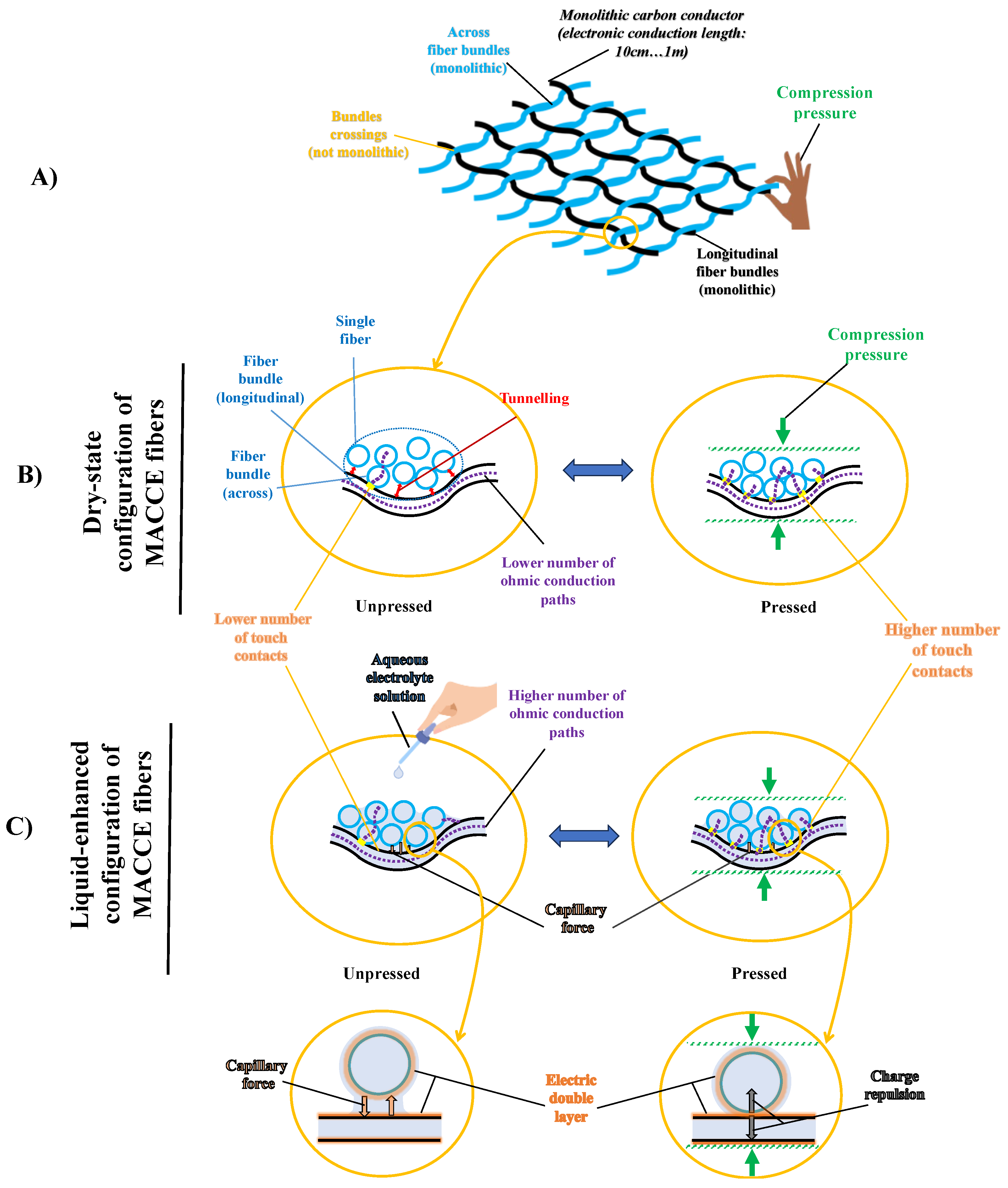

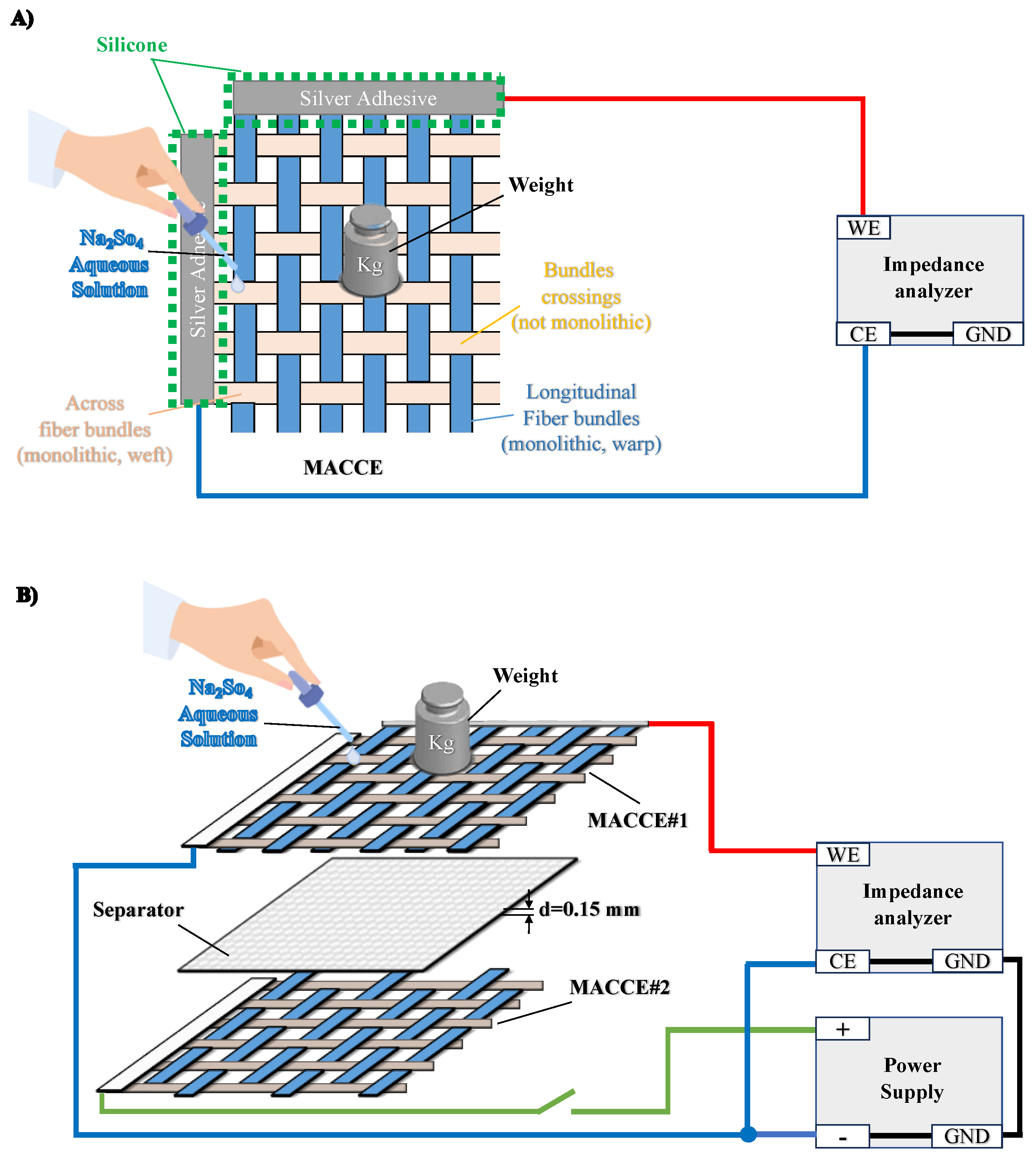
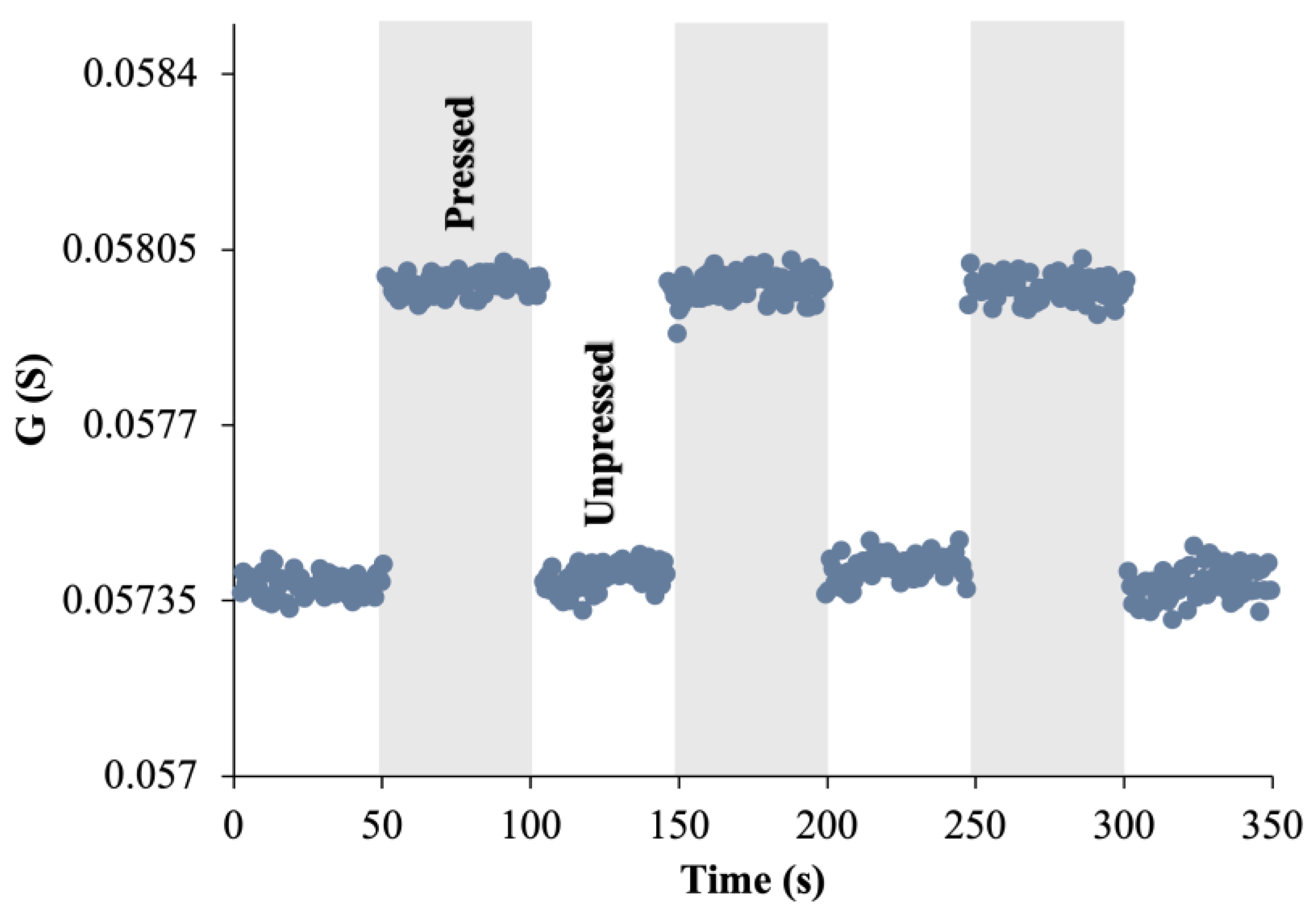

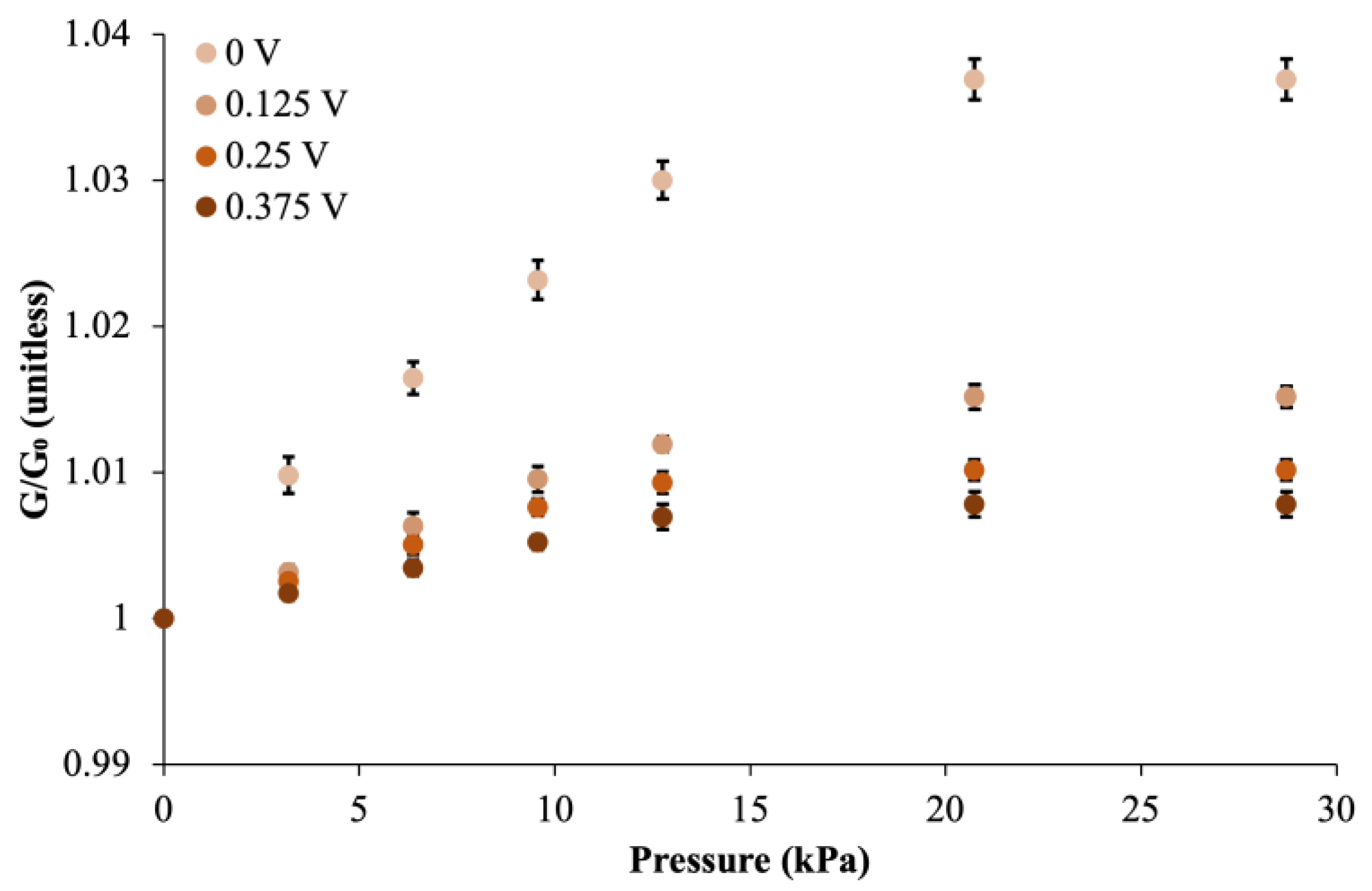
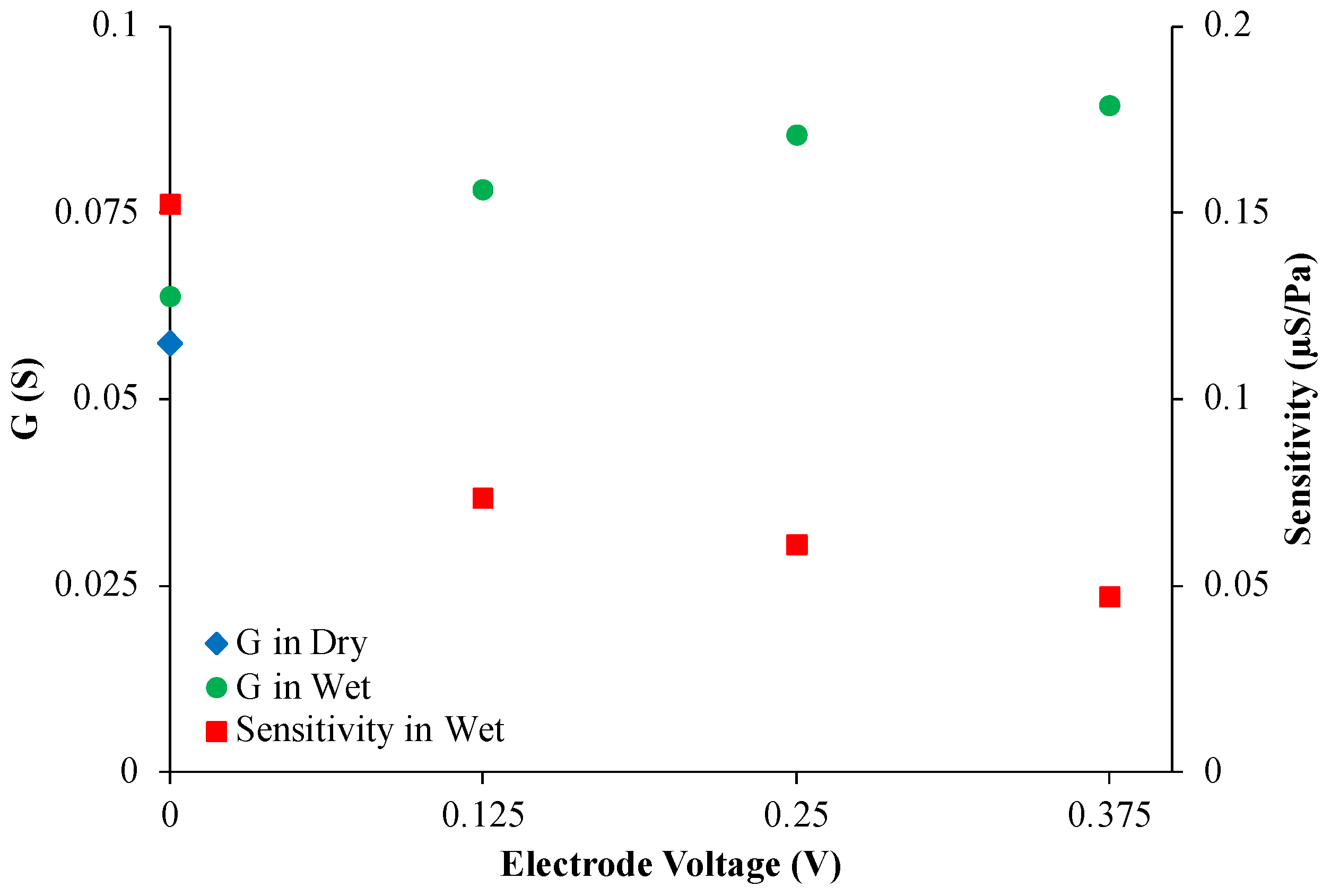
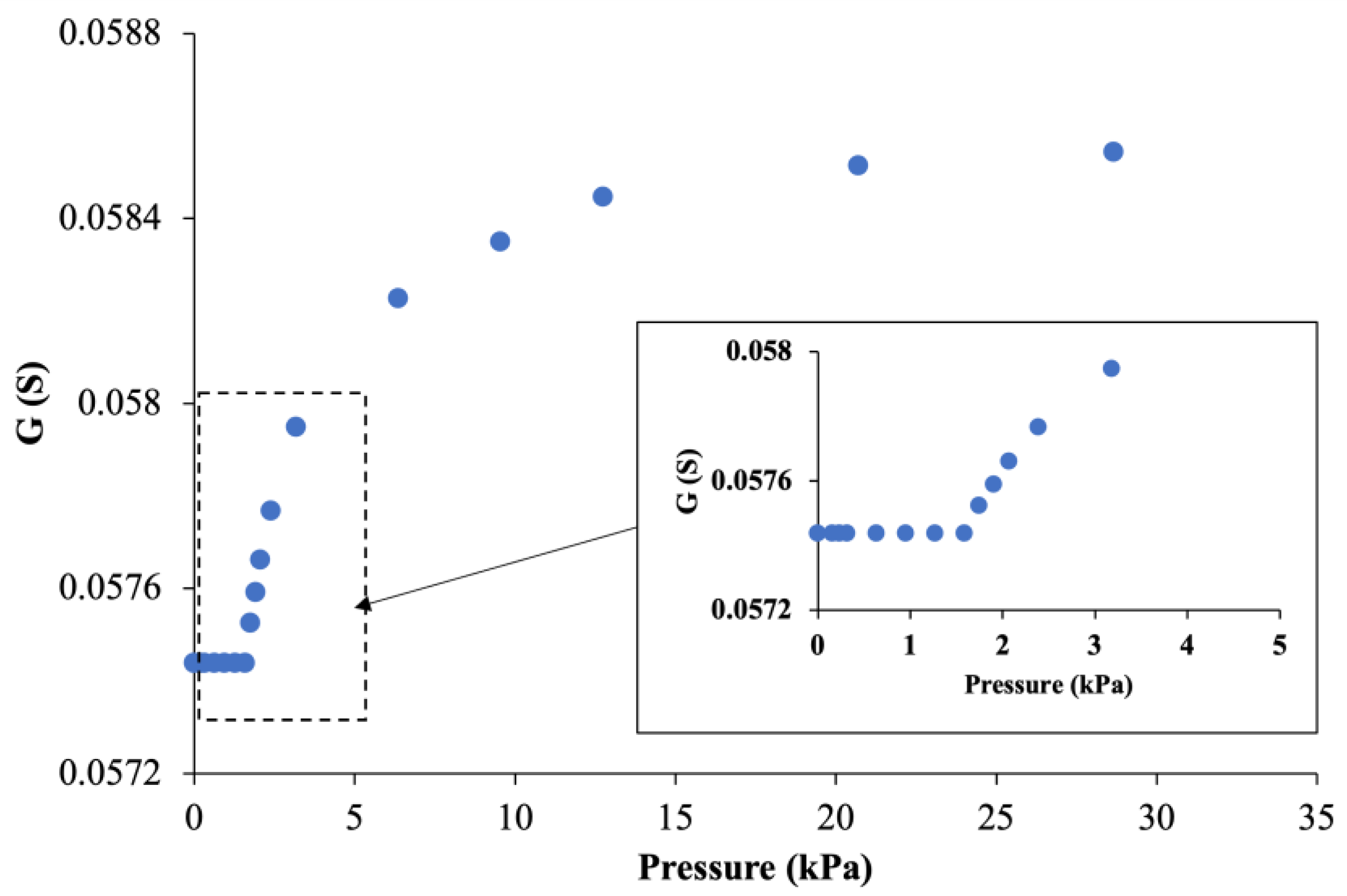
Disclaimer/Publisher’s Note: The statements, opinions and data contained in all publications are solely those of the individual author(s) and contributor(s) and not of MDPI and/or the editor(s). MDPI and/or the editor(s) disclaim responsibility for any injury to people or property resulting from any ideas, methods, instructions or products referred to in the content. |
© 2024 by the authors. Licensee MDPI, Basel, Switzerland. This article is an open access article distributed under the terms and conditions of the Creative Commons Attribution (CC BY) license (https://creativecommons.org/licenses/by/4.0/).
Share and Cite
Syzoniuk, O.; Banerji, S.; Aabloo, A.; Must, I. Uncharged Monolithic Carbon Fibers Are More Sensitive to Cross-Junction Compression than Charged. Sensors 2024, 24, 3937. https://doi.org/10.3390/s24123937
Syzoniuk O, Banerji S, Aabloo A, Must I. Uncharged Monolithic Carbon Fibers Are More Sensitive to Cross-Junction Compression than Charged. Sensors. 2024; 24(12):3937. https://doi.org/10.3390/s24123937
Chicago/Turabian StyleSyzoniuk, Oleksandr, Saoni Banerji, Alvo Aabloo, and Indrek Must. 2024. "Uncharged Monolithic Carbon Fibers Are More Sensitive to Cross-Junction Compression than Charged" Sensors 24, no. 12: 3937. https://doi.org/10.3390/s24123937




